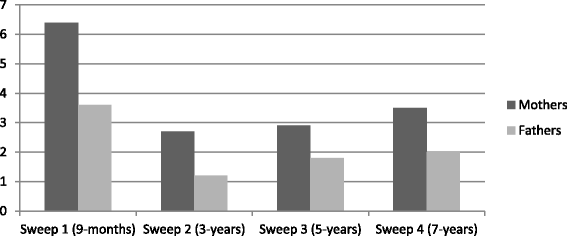The prevalence of depressive symptoms among fathers and associated risk factors during the first seven years of their child's life: findings from the Millennium Cohort Study
- PMID: 27296986
- PMCID: PMC4906969
- DOI: 10.1186/s12889-016-3168-9
The prevalence of depressive symptoms among fathers and associated risk factors during the first seven years of their child's life: findings from the Millennium Cohort Study
Abstract
Background: Increasing evidence suggests that postnatal paternal depression is associated with adverse emotional, behavioural and cognitive outcomes in children. Despite this, few studies have determined the prevalence of fathers' depressive symptoms during the first few years of their children's lives and explored what factors are related to these symptoms. We estimated the prevalence and examined associated risk factors of paternal depressive symptoms in a nationally representative sample of fathers with children aged between 9 months and 7 years old from the Millennium cohort study. The risk factors examined were maternal depressive symptoms, marital conflict, child temperament, child gender, paternal education, fathers' ethnic background, fathers' employment status, family housing, family income and paternal age.
Methods: Secondary data analysis was conducted using the UK Millennium cohort study, which consisted of data from England, Scotland, Wales and Northern Ireland of families with infants born in the year 2000/2001. Data from four sweeps were used from when children in the cohort were aged 9 months, 3, 5 and 7 years old (n = 5155-12,396).
Results: The prevalence of paternal depressive symptoms over time was 3.6 % at 9 months, 1.2 % at 3 years old, 1.8 % at 5 years and 2.0 % at 7 years (using Kessler cut-off points to categorise high depressive symptoms vs low depressive symptoms). Linear regression trends (using continuous measures of depressive symptoms) indicated that both paternal and maternal depressive symptoms decreased over time, suggesting similar patterns of parents' depressive symptoms after the birth of a child, but the decrease was more evident for mothers. Paternal depressive symptoms were consistently associated with fathers' unemployment, maternal depressive symptoms and marital conflict. Socioeconomic factors such as rented housing when child was 9 months and low family income when child was 5 and 7 years were also associated with higher paternal depressive symptoms.
Conclusions: Paternal depressive symptoms decreased among fathers when their children were aged between 9 months to 3 years old. Paternal unemployment, high maternal depressive symptoms and high marital conflict were important risk factors for paternal depressive symptoms. In light of our findings, we would recommend a more family centred approach to interventions for depression in the postnatal period.
Keywords: Depressive symptoms; Fathers; Paternal; Unemployment.
Figures
Similar articles
-
Does father-child conflict mediate the association between fathers' postnatal depressive symptoms and children's adjustment problems at 7 years old?Psychol Med. 2016 Jun;46(8):1719-33. doi: 10.1017/S0033291716000234. Epub 2016 Mar 11. Psychol Med. 2016. PMID: 26965923
-
Fathers' postnatal depressive and anxiety symptoms: an exploration of links with paternal, maternal, infant and family factors.Nord J Psychiatry. 2013 Dec;67(6):407-13. doi: 10.3109/08039488.2012.752034. Epub 2013 Jan 3. Nord J Psychiatry. 2013. PMID: 23286693
-
The prevalence and risk factors for postpartum depression symptoms of fathers at one and 6 months postpartum: an adjunct study of the Japan Environment & Children's Study.J Matern Fetal Neonatal Med. 2020 Aug;33(16):2797-2804. doi: 10.1080/14767058.2018.1560415. Epub 2019 Jan 4. J Matern Fetal Neonatal Med. 2020. PMID: 30563402
-
Bringing birth-related paternal depression to the fore.Women Birth. 2008 Jun;21(2):65-70. doi: 10.1016/j.wombi.2008.03.008. Epub 2008 May 13. Women Birth. 2008. PMID: 18479990 Review.
-
Risk factors for postpartum depressive symptoms among fathers: A systematic review and meta-analysis.Acta Obstet Gynecol Scand. 2021 Jul;100(7):1186-1199. doi: 10.1111/aogs.14109. Epub 2021 Feb 24. Acta Obstet Gynecol Scand. 2021. PMID: 33539548
Cited by
-
Relationship between paternal psychological distress and involvement in childcare among fathers of preschool-aged children: mediating effect of maternal psychological distress.BMC Pediatr. 2019 Sep 3;19(1):308. doi: 10.1186/s12887-019-1688-z. BMC Pediatr. 2019. PMID: 31481061 Free PMC article.
-
Prevalence and Risk Factors of Paternal Postpartum Depression in Multiple Primary Healthcare Centers in Saudi Arabia: A Cross-Sectional Study.Cureus. 2025 Mar 9;17(3):e80302. doi: 10.7759/cureus.80302. eCollection 2025 Mar. Cureus. 2025. PMID: 40201864 Free PMC article.
-
Interventions for Perinatal Depression and Anxiety in Fathers: A Mini-Review.Front Psychol. 2022 Jan 20;12:744921. doi: 10.3389/fpsyg.2021.744921. eCollection 2021. Front Psychol. 2022. PMID: 35126228 Free PMC article. Review.
-
A systematic review and meta-analysis of studies validating Edinburgh Postnatal Depression Scale in fathers.Heliyon. 2022 May 20;8(5):e09441. doi: 10.1016/j.heliyon.2022.e09441. eCollection 2022 May. Heliyon. 2022. PMID: 35663736 Free PMC article.
-
Prevalence and determinants of antepartum depressive and anxiety symptoms in expectant mothers and fathers: results from a perinatal psychiatric morbidity cohort study in the east and west coasts of Malaysia.BMC Psychiatry. 2018 Jun 15;18(1):195. doi: 10.1186/s12888-018-1781-0. BMC Psychiatry. 2018. PMID: 29902985 Free PMC article.
References
-
- McAllister F, Burgess A, Kato J, Barker G. Fatherhood: parenting programmes and policy - a critical review of best practice. London/Washington D.C: Fatherhood/Institute/MenCare; 2012.
-
- Lamb ME. The role of the father in child development. Hoboken, New Jersey: John Wiley & Sons; 2010. https://books.google.co.uk/books?id=dLpOkMwsu-QC&printsec=frontcover&sou....
-
- Panter‐Brick C, Burgess A, Eggerman M, McAllister F, Pruett K, Leckman JF. Practitioner Review: Engaging fathers–recommendations for a game change in parenting interventions based on a systematic review of the global evidence. J Child Psychol Psychiatr. 2014;55(11):1187–1212. doi: 10.1111/jcpp.12280. - DOI - PMC - PubMed
-
- Wong O, Nguyen T, Thomas N, Thomson-Salo F, Handrinos D, Judd F. Perinatal mental health: Fathers–the (mostly) forgotten parent. Asia-Pacific Psychiatry. 2015. doi:10.1111/appy.12204. http://onlinelibrary.wiley.com/doi/10.1111/appy.12204/abstract. - DOI - PubMed
MeSH terms
LinkOut - more resources
Full Text Sources
Other Literature Sources


